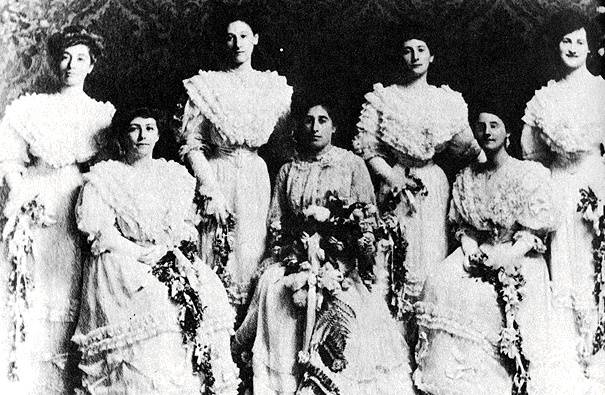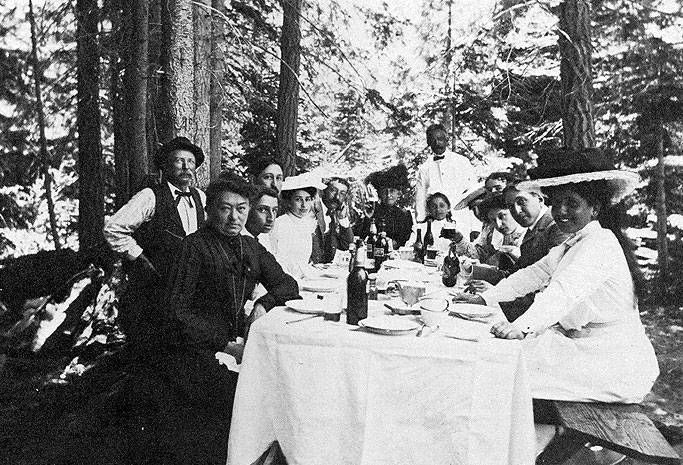The Gilded Circle: Difference between revisions
m 1 revision(s) |
m Protected "The Gilded Circle": finished essay [edit=sysop:move=sysop] |
||
| (5 intermediate revisions by 2 users not shown) | |||
| Line 1: | Line 1: | ||
'''<font face = Papyrus> <font color = maroon> <font size = 4>Historical Essay</font></font> </font>''' | |||
''by Kate Shvetsky'' | |||
[[Image:jewishsf$gilded-circle-photograph.jpg]] | [[Image:jewishsf$gilded-circle-photograph.jpg]] | ||
The "Gilded Circle": interrelated clans linked by blood, marriage, and business. | ''The "Gilded Circle": interrelated clans linked by blood, marriage, and business.'' | ||
In Gold Rush San Francisco, the most economically successful Jewish families formed their own clique - an exclusive Gilded Circle, forged of interrelated clans linked by blood, marriage, and business. This exclusive clan included the families | In Gold Rush San Francisco, the most economically successful Jewish families formed their own clique--an exclusive Gilded Circle, forged of interrelated clans linked by blood, marriage, and business. This exclusive clan included the families Sloss, [[Gerstle Family]], Greenwald, [[Levi Strauss]], Stern, Seligman, Lilienthal, Steinhart, Fleishacker, Zellerbach, Brandentstein, Koshland. The Gilded Circle members had a strict code of behavior: | ||
1. Make money | 1. Make money | ||
2. Marry one's own kind (German Jewish) | 2. Marry one's own kind (German Jewish) | ||
3. Belong to Reform Temple Emanu-El or to no other congregation. | 3. Belong to Reform Temple Emanu-El or to no other congregation | ||
4. Acquire tastes of people of rank | |||
They built houses on the same street and went to the same summer retreat. | |||
[[Image:Gilded-circle-retreat.jpg]] | |||
'''Gilded Circle on summer picnic, 1890s.''' | |||
''Photos: Judah Magnus Museum '' | |||
- | Large families staffed a minimum of six servants and entertained lavishly. Until the early 1900s, guest lists were confined to the Gilded Circle, other socially acceptable Jews, and a smattering of affluent gentiles. Young women who accepted more than the occasional invitation to non-Jewish parties were roundly criticized. | ||
To prepare them for a life of privilege, young women received disciplined training. Nurses and governesses instructed them in proper manners. Tutors gave them art, music, French and German languages. Most boys were permitted to attend public schools before sent east to Harvard or Yale or, alternatively, kept closer to home while attending Stanford or the University of California. The less studious rushed directly into business. Most girls attended private schools. | |||
' | By the early 20th century, when the third generation of San Francisco Jews were coming of age, the circle's code of behavior had solidified into a tradition to be conformed to or, frequently, rebelled against. Circle members had by then begun to mingle freely with non-Jews at social, cultural, and charitable events, and intermarriage was clearly on the rise. | ||
[[Jewish Artists and Writers |Prev. Document]] [[Frontier Jewish Women: Eluding Convention |Next Document]] | |||
[[Jewish | [[category:Jewish]] [[category:Gold Rush]] [[category:1890s]] [[category:Power and Money]] | ||
Latest revision as of 00:35, 11 January 2009
Historical Essay
by Kate Shvetsky
The "Gilded Circle": interrelated clans linked by blood, marriage, and business.
In Gold Rush San Francisco, the most economically successful Jewish families formed their own clique--an exclusive Gilded Circle, forged of interrelated clans linked by blood, marriage, and business. This exclusive clan included the families Sloss, Gerstle Family, Greenwald, Levi Strauss, Stern, Seligman, Lilienthal, Steinhart, Fleishacker, Zellerbach, Brandentstein, Koshland. The Gilded Circle members had a strict code of behavior:
1. Make money
2. Marry one's own kind (German Jewish)
3. Belong to Reform Temple Emanu-El or to no other congregation
4. Acquire tastes of people of rank
They built houses on the same street and went to the same summer retreat.
Gilded Circle on summer picnic, 1890s.
Photos: Judah Magnus Museum
Large families staffed a minimum of six servants and entertained lavishly. Until the early 1900s, guest lists were confined to the Gilded Circle, other socially acceptable Jews, and a smattering of affluent gentiles. Young women who accepted more than the occasional invitation to non-Jewish parties were roundly criticized.
To prepare them for a life of privilege, young women received disciplined training. Nurses and governesses instructed them in proper manners. Tutors gave them art, music, French and German languages. Most boys were permitted to attend public schools before sent east to Harvard or Yale or, alternatively, kept closer to home while attending Stanford or the University of California. The less studious rushed directly into business. Most girls attended private schools.
By the early 20th century, when the third generation of San Francisco Jews were coming of age, the circle's code of behavior had solidified into a tradition to be conformed to or, frequently, rebelled against. Circle members had by then begun to mingle freely with non-Jews at social, cultural, and charitable events, and intermarriage was clearly on the rise.


